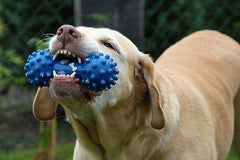
If your dog has been licking, biting, or scratching a lot recently, he may have developed a hot spot. Hot spots are one of the most common skin conditions in dogs, especially during summer.
Hot spots are incredibly itchy and can spread rapidly. But rest assured, these painful, oozing sores have specific treatments that your veterinarian can help your dog with.
What are hot spots?

Dog hot spots, also known as acute moist dermatitis, are localized skin inflammation and bacterial infection areas. Dog hot spots are sometimes called "summer sores" since they tend to develop in the summer months when heat and humidity are high.
A dog hot spot is painful and incredibly itchy. Dogs hot spots can appear anywhere on your dog's body. However, they are commonly found on the face, neck, limbs, or hips.
What do hot spots look like?
Hot spots are red areas of infected skin. They will begin as a small red area that can be confused with an insect bite and rapidly worsen and spread in days.
Hot spots may look like open, oozing wounds and usually cause some hair loss. Dogs hot spots may look like a sizeable wet scab that oozes. In some cases, they may even bleed.
What causes hot spots?

Hot spots are one of the most common skin conditions in dogs since they have many possible causes. Dog owners need to identify the underlying cause to prevent hot spots from being chronic.
Hot spots appear in the first place after obsessive licking, biting, and scratching. Unfortunately, this behavior often causes secondary infections, which may increase dogs' itchiness and create a perpetual cycle of itching and scratching.
This is why treating hot spots early on is the best way to heal them.
Here are the known leading causes of hot spots in dogs:
- Allergies. Dogs with environmental allergies may develop rashes and irritated areas after contact with environmental allergens such as pollen and grass. This irritation can then lead to scratching and, as a result, hot spots. Food sensitivities and allergies to certain ingredients may also irritate a dog's skin.
- Moisture. Dogs that are often wet from swimming or bathing are more prone to developing hot spots. Less frequent swims, baths, and proper coat drying can help reduce the risk of hot spots.
- Parasites. Some dogs are allergic to the bites of fleas, ticks, and other small insects. Discuss parasite prevention with your vet if you suspect this to be the case with your dog.
- Boredom. As simple as it may sound, some dogs end up licking and scratching out of boredom. Increased exercise and toys such as puzzle toys may be the solution if that's the case.
- Infections. Infections caused by other conditions may lead to hot spots. For instance, dogs prone to ear infections may develop hot spots more frequently.
- Anal gland issues. Dog anal glands can sometimes get inflamed and cause irritation and infections, leading to itchiness and scooting. Dogs may start to bite and lick around the anal area, which can lead to hot spots.
- Contact irritants. Many household cleaning products can be skin irritants and lead to itchiness.
- Dirty or matted hair. A dirty and matted coat can lead to skin irritation and infections.
It's essential to find the underlying cause of your dog's hot spot to prevent it from happening again. Some of the reasons listed above may be harder to diagnose, such as food allergies, but solving these issues may lead to a happier and healthier pup.
Breeds prone to hot spots
Dog breeds are not created equal when it comes to their coat. Some breeds are predisposed to developing hot spots due to their thicker coats. Sometimes, even dogs with a thinner coat will still develop hot spots due to frequent swimming and bathing.
Hot spots on dogs affect all breeds, but the following breeds are at a higher risk due to excess moisture that can get trapped in their thicker coat:
- German Shepherds Dogs
- Labrador Retrievers
- Rottweilers
- Saint Bernards
- Golden Retrievers
- Siberian Huskies
- Bernese Mountain Dogs
- Border Collies
- Great Pyrenees
- Newfoundlands
These breeds and other dog breeds will be at a higher risk of developing hot spots during the summer months when temperature and humidity are high.
Symptoms of Hot Spots on Dogs

Hot spots on dogs are pretty easy to spot due to their redness and the dog behavior associated with them. However, please remember that other skin conditions may display similar symptoms. Consulting your veterinarian will help diagnose a dog's hot spot properly.
Typically, hot spots on dogs appear on the head, limbs, and hips. You may also notice the following symptoms:
- Redness
- Swelling
- Hair loss
- Excessive licking, biting, or scratching
- Itching
The spot in question will typically be moist and may discharge pus or fluid, leading to crusting and matted fur.
Are hot spots contagious?
Most hot spots on dogs are not contagious to humans and other pets. Instead, hot spots are often caused by bacteria. However, if the underlying cause of a dog's hot spot is fungal or parasitic, then it may spread to other dogs and humans.
Treatment for Hot Spots on Dogs

Since hot spots on dogs are pretty standard, the treatment is also well-known by veterinarians. So if you suspect your dog may have a hot spot, consulting your veterinarian should be your first step.
Dog hot spot treatment often involves topical creams and oral antibiotics that can only be prescribed. Please refrain from trying to use human topicals as they may cause more harm than good.
Since a dog's hot spots can worsen in days, seeking treatment as early as possible is essential. The main benefit of seeking veterinary help is that they will help you identify the underlying cause, which can help prevent hot spots from recurring.
Typically, treating canine hot spots will involve a combination of the following:
- Clipping the surrounding hair around the infected area to prevent matting.
- Cleaning the hot spot with an antiseptic solution such as chlorhexidine.
- Bathing with a chlorhexidine shampoo for dogs.
- Prescribing topical or oral antibiotics to treat secondary bacterial infections.
- Prescribing topical or oral steroids to control inflammation and decrease itching.
- Prescribing allergy medication to help prevent dog itching.
- Using medicated wipes or solutions to clean the affected area daily.
- Applying an Elizabethan collar (e-collar or "cone") to prevent continued licking, biting, and scratching.
Veterinarians claim that once treatment has begun, you may notice a significant improvement in as little as 3 to 7 days.
Can hot spots go away on their own?
The main reason why hot spots can't go away on their own is that your dog will be tempted to lick, bite, or scratch the affected area multiple times a day.
On top of that, bacterial and fungal skin infections rarely go away on their own and require specific treatment.
What will the vet do to treat hot spots?
What your vet will do and prescribe depends on the severity of the hot spot. Most veterinarians will use a combination of oral and topical medication and a cone.
Veterinarians may prescribe additional medications to address the underlying cause, such as flea & tick prevention, ear cleaning solutions, etc.
What home remedies can help treat hot spots?

Since hot spots are infections, using home remedies such as Apple Cider Vinegar is not recommended. Home remedies may help prevent and condition your dog's skin and coat. However, they are of little help once a bacterial or fungal infection has set in.
If you are unable to get to the vet right away, there are still a few things you can do to help your dog:
- Trim the area around the hot spot with dog hair clippers. The goal is to get more air to the affected area and prevent excess moisture from slowing down the healing process.
- Clean the skin with a mild, water-based antiseptic spray or wipe or an antibacterial shampoo.
- Place an e-collar on your dog to help prevent him from worsening the hot spot.
Once a hot spot is treated, there are a few home remedy ways you can help future hot spots.
Preventing Hot Spots
Hot spots are usually the consequence of a condition, a behavior, or both. Whether it is anal sac disease, flea allergy, ear infections, excessive moisture from swimming, or something else, finding the underlying cause is the best way to prevent recurring hot spots on dogs.
As a rule of thumb, good parasite prevention and management of allergies are good first steps. And, whenever a dog goes swimming or is bathed, thorough drying will also help.
Are hot spots likely to recur?
Unfortunately, yes. If your dog experiences chronic hot spots, you may want to talk with your veterinarian about getting your dog testing for hypothyroidism, skin and food allergies, and joint problems.
How to improve your dog's skin health

Improving your dog's skin health is one of the best ways to help prevent hot spots. In addition, a healthy skin barrier and proper grooming can significantly support your pet's health.
High-quality nutrition
Nutrition can be the source of issues such as allergies and be the solution in some instances. For instance, eating chicken if your dog is sensitive to chicken may damage skin, itching and hot spots on dogs.
There are 11 typical dog food allergens. Sometimes, switching the main ingredients in your dog's kibble may solve your dog's allergies.
Add EPA and DHA
Many dog owners report that adding Omega 3 fatty acids is highly beneficial in treating allergies. A great source of fatty acids is fish oil. Fish oil is a delicious food topper that will make any kibble, wet food, or raw food instantly more appealing.
A popular fish oil option is salmon oil. We offer our own Wild Alaskan Salmon Oil Formula at Petsmont, which you are welcome to check out while you research the various fish oil options.
Parasite prevention
Flea and tick prevention is paramount depending on where you live, the time of year, and if your dog is allergic to flea bites. If your dog is allergic to flea bites, look into prevention that works before the fleas bite your dog's skin: otherwise, your dog will get a reaction anyway.
Properly drying your dog's thick fur
Since hot spots are sometimes caused by moisture trapped in your dog's fur, it is essential to dry your dog after he goes swimming or bathing thoroughly. This is a great way to help prevent skin infections, moist dermatitis, and hot spots on dogs.
Properly groom your dog
Proper routine grooming can help support dogs' skin health and reduce the risk of hot spots. In addition, regular brushing and bathing can prevent matted fur and remove allergens and irritants stuck on dogs' skin and coats.
Provide your dog with immune support
Pet lovers may not know this, but the immune system is the center of their dogs' health. A robust immune system can fight off allergies better and faster. One of the proven ways to support dogs' immune systems is with turkey tail mushroom.




